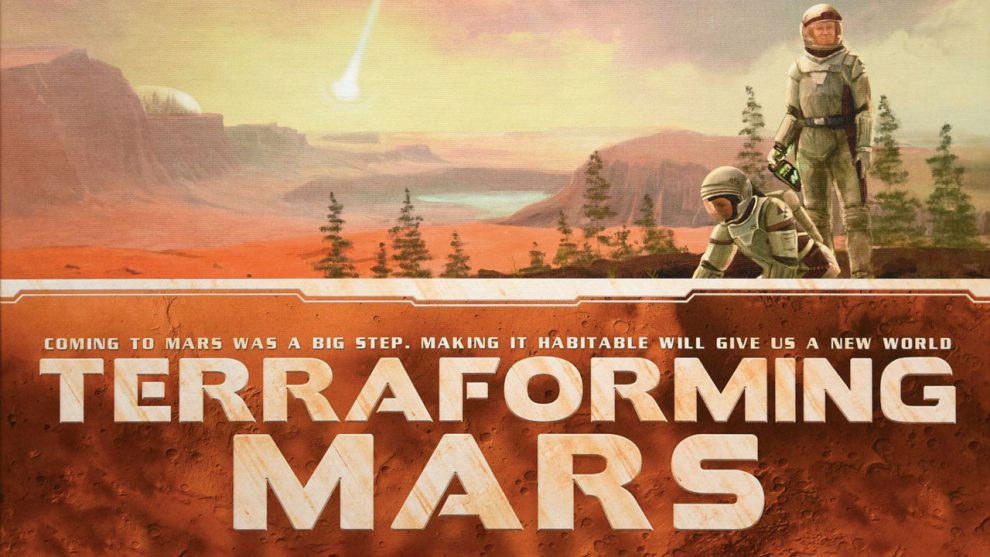Introduction
Eventually we’re going to need to leave earth. Mars seems like a logical destination, and much has been made of how we’re going to make Mars habitable. Terraforming Mars lets you tackle that challenge as you play as a corporation vying to make Mars habitable for human existence.
Terraforming Mars is a heavy economic euro-game set in a fresh science-fiction theme. Success in Terraforming Mars requires a combination of tactical play from turn to turn and long-term strategic planning.
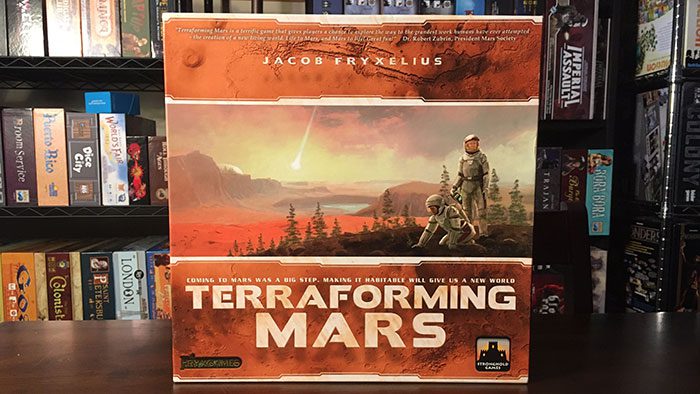
I love Terraforming Mars, and it’s one of the most popular games of 2016; I consider it the best game of the year. This review will go through my thoughts on the game as I discuss some of the most common pros and cons. I do give a brief overview of the mechanisms of the game, but it’s only to serve as an introduction. If you’re interested in a more in-depth review I recommend Humanity’s Quick Start Guide to Terraforming Mars.
Gameplay
In Terraforming Mars, each player starts with a corporation which gives that player a unique starting ability and starting resources. The goal of the game is to score the most victory points through developing an engine to produce resources and leverage your starting power. The game continues until the players have raised the oxygen level to 14%, the surface temperature to 8°C, and have placed 9 ocean tiles.

There are six major types of resources in the game: Mega Credits, steel, titanium, plants, energy, and heat. These are represented by cubes placed on the player boards. The game is divided into generations during which players will take actions based on cards in their hands, actions available in their tableau, or use standard projects available to everyone. Once all players have passed, they all generate the six types of resources based on their current production level.
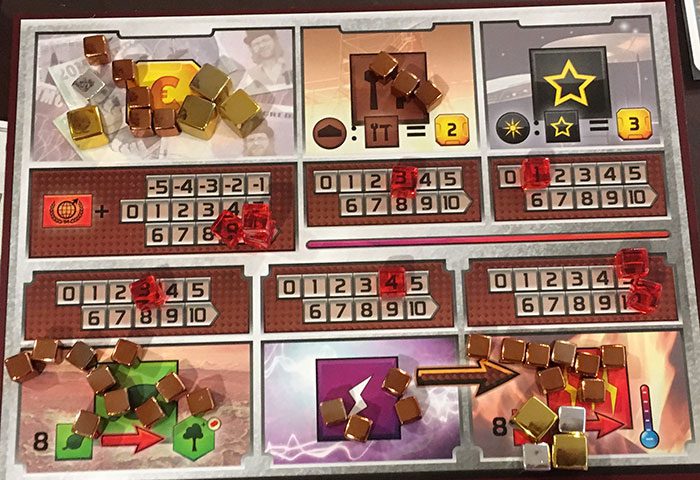
Each round begins by dealing four cards to each player. The players can choose to pay three mega credits for each card they want to add to their hand. These cards can also be drafted to reduce the variability of random card draws.
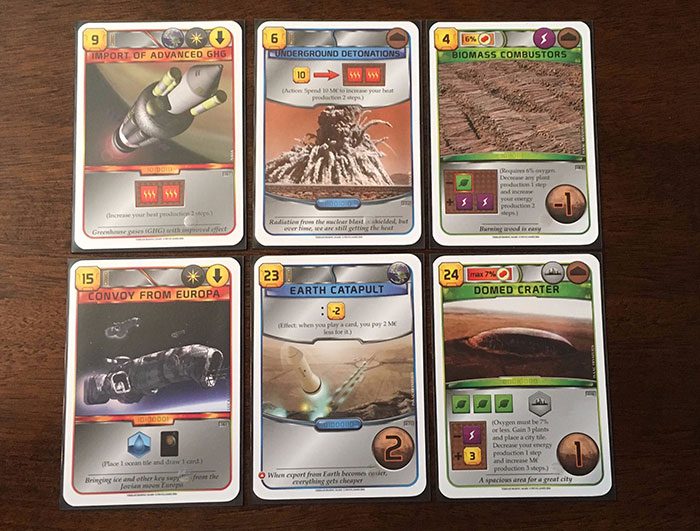
On a player’s turn they can take one or two actions or pass for the remainder of the generation. In order to play a card from their hand, they need to pay the cost, listed in the upper left hand corner, and they need to have met any requirements for the card (also shown in the top left). The card is then added to your tableau and you gain the benefits shown. These cards let you do a variety of actions ranging from increasing resource production, to stealing resources from other players, to allowing you to place oceans or build cities.

Along with taking these actions, players can pay money to use standard projects which can increase the oxygen level, increase the temperature, or place out an ocean, amongst a variety of other actions.

Once the oxygen, temperature, and ocean levels are all maxed out, the game ends and the players score. Each greenery tile you own counts as one point. Each city you own scores you one point per greenery tile adjacent to it no matter the owner. You get one point per ocean tile you place, one point per temperature level you increased, and one point per oxygen level you raised. Many cards you play will gain you points as well. Finally, there are end of game awards which you can pay to include in the game. The winner is the player who scored the most victory points.
Pros
Terraforming Mars is smooth and well-polished. There aren’t really any fiddly mechanisms in the game (except for the player boards – more to come on that), and the turn structure is well designed. The balance between making one or two actions on your turn creates really interesting dynamics. The one complaint here is that as you build a tableau of actions in front of you it can be hard to remember all of them at all times.
At times, triggering the end game is a little frustrating since it may seem very dependent on a certain player or two who have an engine built up for one of the given end game triggers. That’s why there are the standard projects which let you complete any of the end game triggers as needed!

A lot has been made to due about the player interaction “take-that” cards. They’re not that bad. Seriously. I understand if you don’t like any “take-that” in your games; I really do because I fall into that same camp. If you listen to the commentary on this game, you might think that every card in the game (and there are about 210) has a negative effect on the other players in the game but really only about 15% do. I find that, as I’m playing, I’m rarely inclined to take the “take-that” cards anyways, since I can typically find other cards that interest me.
If you do the math on the value of the “take-that” cards, they affect one player and change your victory equation with respect to that player whereas other cards you can take help you relative to all of the other players. Even when I do feel the need to take one of the “take-that” cards because a particular opponent is so far ahead or hoarding resources, the cards don’t set the player back that far. Some reviewers have made it out that after getting hit with a “take-that” card you’re playing Stone Age while everyone else is still Terraforming Mars (had to make the lame board game joke).
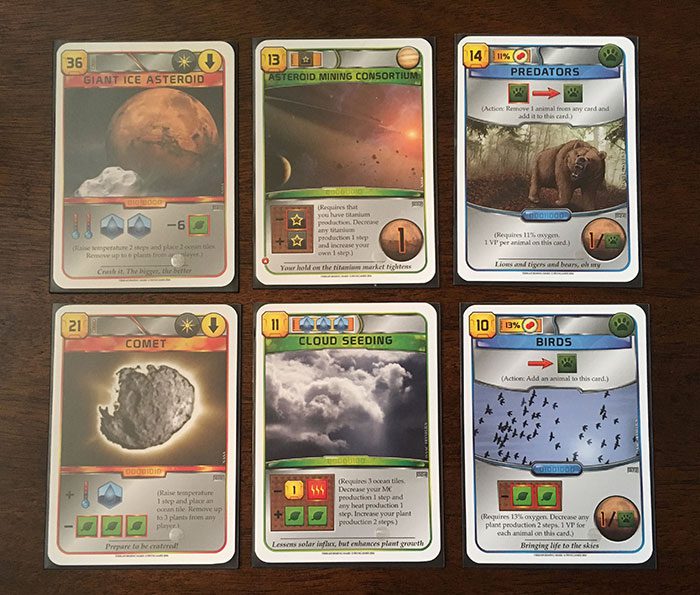
One of the primary mechanisms is drawing and purchasing cards. This can produce a degree of randomness in the game but the designers included a variant which helps to mitigate that. The designers recommend drafting the cards you purchase instead of just buying cards from the hand you draw. I really like this variant in that it gives you more interesting decisions to make and increases the interaction of the game. It also decreases the perceived randomness of the game, though I don’t fully buy into the idea that the game is overly random.
The designers also include a second variant in the box with the corporate era expansion, which adds in additional cards and corporations. Both of these variants significantly improve the game and I play with them always including when teaching new players.
Engine building is one of my favorite things in board games, especially when the engine has multiple levels. Terraforming Mars builds one of the best engines I’ve experienced in a board game. The buildings you construct, and to a lesser extent the event cards, allow you to set up a production engine which powers your corporation by producing mega credits, steel, titanium, plants, energy, and heat. This is the first level of your engine and the most ubiquitous one in the game. The second level of the engine is the blue action and effect cards you can set up throughout the game. These cards let you use your resource production for your gain. The interplay and synergy between these two levels make each play of Terraforming Mars different for you. Very few games I’ve played have as much variety as playable combinations that can emerge throughout the game.
Cons
A lot has been made about the quality of the player boards and their low quality, and they are BAD. The player boards rely on setting plastic cubes onto resource indicators identifying your production of those resources each round. This is upsetting. In the era of games like Scythe, which in my opinion is an inferior game in gameplay quality but ridiculously superior in component quality, it’s insane for a game with a price tag as high as Terraforming Mars to have component quality this low. Give us inlaid spaces like Scythe, or tracker wheels, or literally anything else. Come on Stronghold Games, try again. There are several companies which offer solutions to this, but paying $20+ on top of the base game price is a lot to ask.
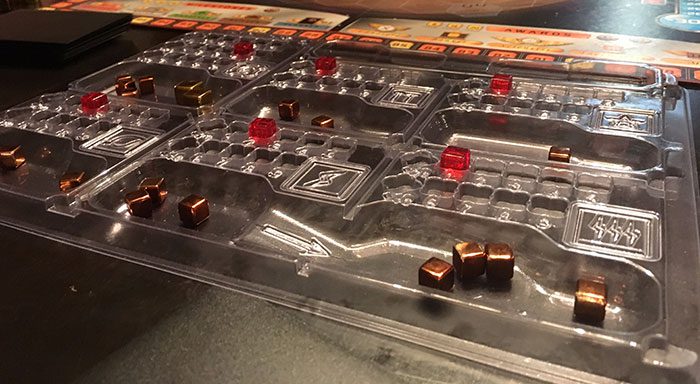
One of the after-market solutions to the player tray
The box says 90-120 minutes for Terraforming Mars and games can definitely exceed that. AP prone players will have problems with this game especially with the drafting mechanism added in. There are a lot of decisions to be made (but in a way not really, more on that later) and if you like to take a lot of time mulling over your decisions, prepare for your friends to get a little antsy.
No matter if the game is player with 1-5 players, the end conditions don’t scale. This creates some strange situations with your engine building. I’ve found that the game plays best with 3-4 players. You’re given enough time to build and get running, but there aren’t usually turns where your engine is just sitting stagnant. In contrast, in a two player game your engine runs for 2-3 turns too long and for the most part you’re just advancing the trackers for the game and scoring points. There are very few decisions to be made at all and, overall, those experiences are a little off-putting. With five players you don’t really have enough time to run your engine fully and it may be just getting built as the game is ending. The engine building is the most fun part of the game, but without getting to see your engine really accomplish what you set out to, it falls a little flat.
My biggest complaint of the game is that your corporation defines much of your strategy throughout the game. Though I do think the best player will win a majority of the games, a player following the strategy outlined by their corporation will generally beat a player who doesn’t. Now this isn’t a bad thing necessarily. Being able to value cards properly and fit different cards into your strategy is still an important part of the game. At the same time, as I play the game it feels like there are certain cards, milestones, and awards almost designated for certain corporations.
For example, if you have the Mining Guild you’re most likely going to end up with the builder award? If you get Ecoline, your plant production at the end of the game with be high and you’ll probably end up with the gardener award. On the other hand, corporations like UNMI and Credicor are more interesting, they essentially let you design a strategy around whatever works best in your starting hand. I’d also argue that it’s easier for new players to have one of the more rigid corporations than the basic corporations since its easier to develop a strategy around them.
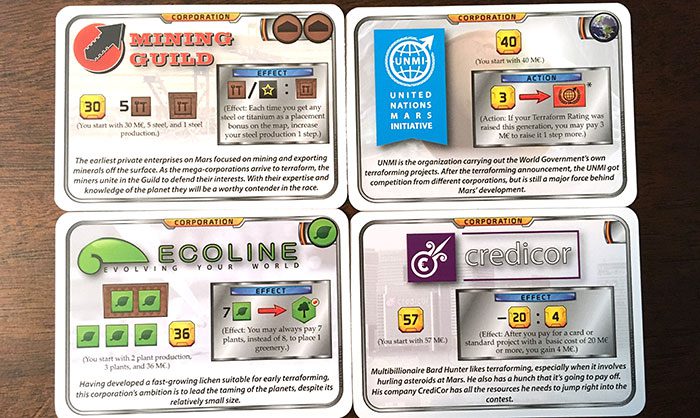
I’ve seen complaints about the variety in the artwork on the cards. Honestly I don’t really notice that or care about it. Your mileage may vary on that one.
A Slightly Different Perspective

Hey, there, Jesse the BoardGameBard here. Sorry to interrupt, but I have some comments I’d like to share. First of all, a bit of background. My preference in games usually differs greatly from Andrew’s. He tends to enjoy more Euro-style games, where I trend towards American-style games. It’s a fairly broad generalization, to be sure, but that should give some context as to my remarks. Hopefully, I can offer people a different perspective, since I’m coming from a very different place, gamer-wise.
Andrew, I feel like you’ve left off the best part about the game: the THEME! It’s the element of the game that draws me in and keeps me engaged. The “hard sci-fi” (science fiction based in realism) theme of terraforming a new planet is intrinsically interesting. The 20th-century space race captured the hearts and minds of the world. This game did the same thing for me. The actions you do, via the cards you play, thematically make sense. Spreading plant life across the planet increases the oxygen level. Creating oceans and raising the planet’s temperature makes the planet more habitable. The amazing thing is that every single one of the 200+ cards is unique. Whether I’m equipping RAD suits, creating hydroponic plant life, or controlling asteroids as they careen towards Mars, the game makes me feel like I’m doing my part to further the human race’s quest for space exploration and discovery.
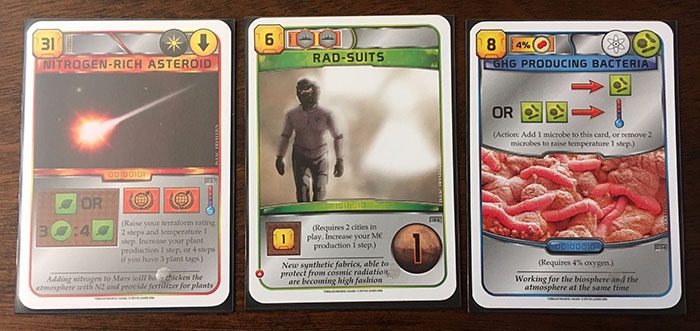
Another big plus for me is the built-in variability. There are over 200 unique cards, but in a given game you may only see about half of them. This means that every time you play will be different. Plus, the 12 different corporation cards mean that your overall strategy may change as well. While variability between games may not be the most important aspect of a game to me, it certainly adds to the continued enjoyment. Plus, I’m much more likely to buy a game if I know I can get a good number of plays before it gets stale.
Of course, I would be remiss if I didn’t talk about some of my cons, though. In addition to the component quality and “potential for analysis paralysis” concerns mentioned above, one potential detriment that I see is that Terraforming Mars, even underneath a convincingly thick layer of awesome theme, is still at its heart an engine-building victory point game. If, for whatever reason, you’re not able to get your engine up and running in the first few turns, you’ll be quickly left behind. There isn’t a catch-up mechanic to speak of. The players who are able to do more terraforming actions (raise the temperature, make an ocean, make a forest) then receive more money in the next round that will let them buy and play more cards. The “rich get richer” phenomenon will mean that It’s easy enough to get left in the dust to a more experienced player.
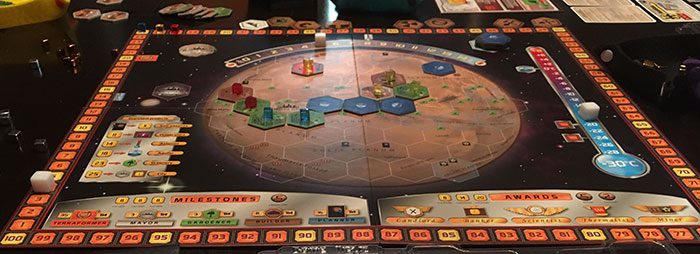
Andrew mentioned his issue with one’s drawn corporation defining one’s strategy. I don’t think this would be a big issue if it weren’t for the potential randomness of the card draws. Sure, adding in drafting can help mitigate this, but due to the sheer number of cards in the game, you may not even have a chance to get enough of the cards that align with your corporation’s strategy. In one game that I played, my corporation was plant-focused, but throughout the course of the game, I only saw five or six plant cards. This forced me to refocus my strategy a bit, and ultimately finish dead last by a good margin. If you are the type of player who prioritizes winning, your first few plays of Terraforming Mars may leave you unfulfilled.
Overall, I really enjoyed my plays and think it’s a fantastic game. The theme is rich and engaging, the mechanics of the game make sense thematically, and the built-in variability allows for multiple unique playthroughs. It’s a game that I’ll almost never turn down, and I’ll definitely want my own copy. (at least as soon as it comes back into print, that is.)
Back to you Andrew for your final thoughts.
Final Thoughts
Terraforming Mars is fantastic. It’s rare to find a game with smooth mechanisms that ties an interesting theme tightly with gameplay. Holding a hand of cards and trying to determine an optimal way to play them is one of my favorite gameplay mechanisms, and Terraforming Mars handles this so well. The economy in the game is tight, but it’s never crippling. As Jesse mentioned there is a runaway leader problem, but at the same time your engines also provide you with enough income to always do some interesting things on your turn.
Though I had a few cons for the game, most of them are aesthetic or can be fixed by avoiding certain player counts, or letting players choose from a few more corporations. The pros of this game significantly outweigh the cons. I really hope it’s clear from both my and Jesse’s praise of this game that Terraforming Mars is a unique game in that it may appeal to gamers of all ilks and interests.
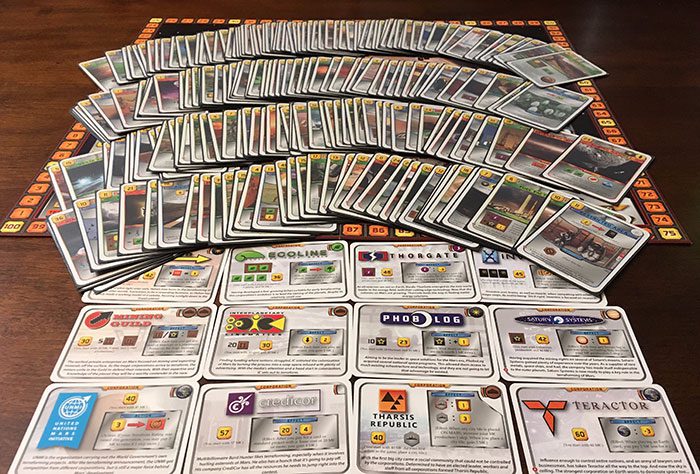
After about 20 games of Terraforming Mars, I can honestly say no two games have felt the same. The amount of replay-ability in the box, between the cards and the corporations, is superb. Also, though Terraforming Mars is a fairly deep economic game, the gameplay is easy enough to teach to players with a variety of skill levels. If all of that isn’t enough, there are already four expansions announced for the game. The dedication of the designers to this title is way above average, and something worth being very excited about. I can’t recommend Terraforming Mars enough.
If this sounds good you might also like
The Great Zimbabwe by Splotter Spellen. TGZ has a similar board presence with heavy economic principles. If the engine building in Terraforming Mars appeals to you, then look into games like Manhattan Project: Energy Empire or Saint Petersburg. Also, if the Mars theme is for you, you should check out the upcoming release of First Martians.


